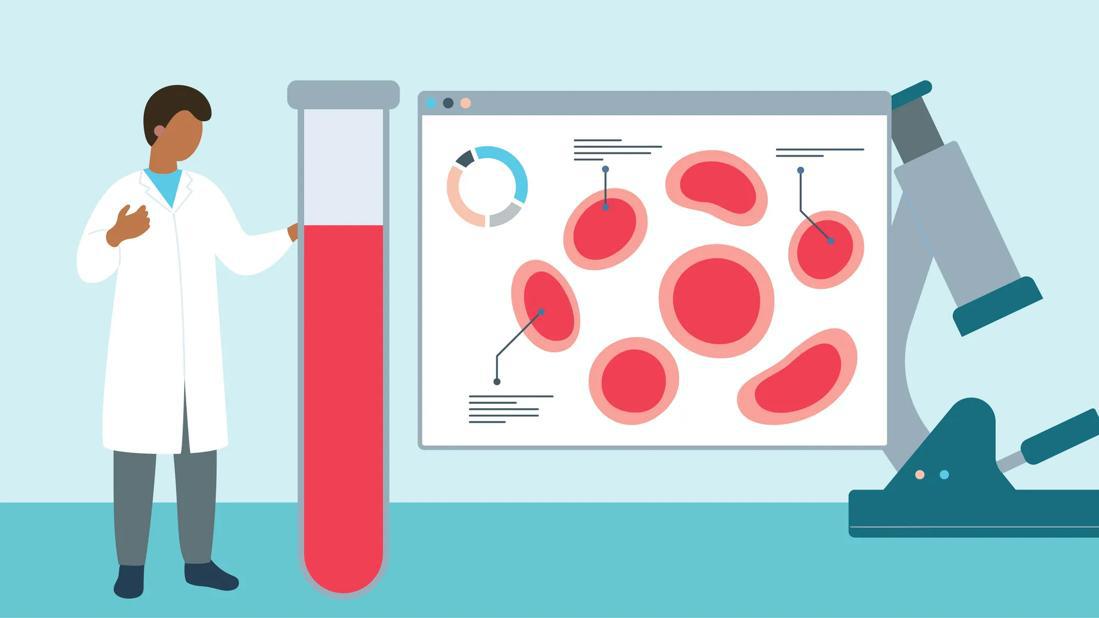Hemophilia A vs. B: What’s the Difference?
Hemophilia A and B are both inherited blood-clotting disorders — the difference is in clotting proteins

If you or someone you love has hemophilia, you may already know there are different types. But what’s the difference between hemophilia A vs. B? And is one worse than the other?
Hematologist James Martin, MD, breaks it down.
Hemophilia A and B similarities
Both hemophilia A and B are inherited bleeding disorders. They’re conditions that cause your blood not to clot properly. That can result in symptoms like:
- Excessive bruising
- Bleeding heavily after an injury or surgery
- Sudden nosebleeds
- Internal bleeding that causes pain in the joints
- Brain bleeds
“Hemophilia is a deficiency of proteins that help your body form blood clots,” Dr. Martin explains. “When certain clotting proteins aren’t present or working fully, your body has a harder time making clots to stop the bleeding.”
Hemophilia A and B are passed through families in the same way. They’re X-linked recessive conditions. This means they affect men more frequently than women, as men only have one X chromosome.
Because women have two X chromosomes, they can carry an abnormal clotting factor gene, but not necessarily have hemophilia.
So, if a mother carries the gene for an abnormal clotting factor, there’s a 50% chance she’ll pass it on to a son (because he has only one X chromosome). Her daughter would have a 50% chance of being a carrier of the faulty gene (because she has two X chromosomes).
Women who are carriers of the gene can have some symptoms of hemophilia, but it’s less common. And when they do have symptoms, they’re usually mild.
Key differences: Hemophilia A vs. B
So, what sets hemophilia A and B apart? Dr. Martin walks us through the differences.
Causes
The biggest difference between hemophilia A and hemophilia B lies in which blood clotting factor is deficient. Your body’s blood clotting pathway is a complex process that relies on numerous different proteins and other molecules.
These proteins are called clotting factors and are assigned numbers:
- Hemophilia A is a deficiency in clotting factor VIII (8).
- Hemophilia B is a deficiency in clotting factor IX (9).
A third kind of hemophilia, hemophilia C, is a deficiency in clotting factor XI (11).
Rarity
Hemophilia is a rare condition. But, relatively speaking, hemophilia A is more common than hemophilia B. Hemophilia C is the rarest.
An estimated 33,000 men in the United States have hemophilia, according to the U.S. Centers for Disease Control and Prevention (CDC). Researchers estimate that hemophilia A accounts for about 80% to 85% of hemophilia cases.
Treatments
“There have been a plethora of treatments to help with both hemophilia A and B that have come out in just the past few years,” Dr. Martin shares.
Let’s look at the options.
Treatments for both hemophilia A and B
- Clotting factor replacement therapy has been the standard treatment for hemophilia since the 1990s. It’s an IV therapy to add the deficient clotting factor to your blood. It’s given preventively in people with severe hemophilia or as needed for people with milder forms of the condition.
- Tissue factor pathway inhibitorswork by “swinging the pendulum to make your blood more pro-clotting than pro-bleeding,” as Dr. Martin puts it. Your body has checks and balances in place that help keep your blood-clotting processes from going overboard. These medications help to override that natural response, enabling your body to form blood clots better.
- Fitusiran (Qfitlia®) is a medication that helps boost your body’s ability to form blood clots. It does that by lowering levels of antithrombin 3, a protein that helps to keep blood from clotting too much. It’s an injection you give yourself every two months.
- Gene therapy replaces the gene that’s responsible for the deficient clotting factor. A working gene is delivered through a one-time infusion. “It’s a way for people to, essentially, receive the ability to make the clotting factor themselves,” Dr. Martin explains.
Treatment for hemophilia A only
- Emicizumab (Hemlibra®)is a medication that’s given via self-injection. “It takes the place of factor VIII,” Dr Martin says. “It brings factor IX and factor X together, bypassing the need for factor VIII.”
Which is more severe: Hemophilia A or B?
Neither hemophilia A or B is “worse” than the other. No matter which kind of hemophilia you have, the severity of the disease and the extent to which it affects your life can vary widely.
“You can have any spectrum of disease with either of them,” Dr. Martin clarifies.
Most cases of severe hemophilia are detected at birth. Thanks to prenatal testing, it can even be screened for before your baby is born. Milder forms of hemophilia may not be noticed until childhood or later.
Normal blood clotting factor activity is around 70% to 80%. You’ll be diagnosed with hemophilia if your blood clotting factor activity is:
- Less than 1%: Severe hemophilia
- 1% to 5%: Moderate hemophilia
- 5% to 30%: Mild hemophilia
Things like abnormal bleeding symptoms can be a clue to your physician to test for hemophilia. But only a blood test can determine whether you have hemophilia A or B.
If hemophilia runs in your family or you’re concerned about severe bleeding, talk with a healthcare professional. They can check for hemophilia A and B and other concerns and help find treatment and management solutions to help live a safer, healthier life.